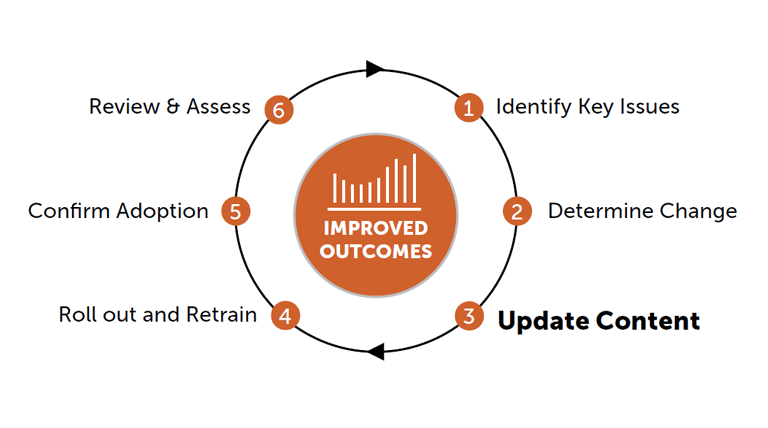Work instructions are for your team, not the regulators
Write content for the people who’ll use it (while keeping the regulators and auditors happy too)
- Human error is one of the biggest unanticipated costs in every business.
- Having a standard that’s easy to follow ensures compliance.
- Creating content that makes sense to your team and doesn’t just regurgitate regulatory language can ensure employees actually follow it.
- Getting good content into the hands of your frontline teams helps them work autonomously and get things done quickly and accurately.

The “45 minutes of hell” began on August 1, 2012, when Knight Capital Group, the largest trader in US equities at the time, began to process orders from their clients.1,2
The day before, the company had made a critical error while implementing a software upgrade to their automated trading system. Poor work instructions and a lack of review by a second employee caused the software to be installed on only seven of their eight servers.
The mistake caused the system to produce an endless loop of orders that had no basis in reality. After 45 minutes of trading, they were finally able to stop the system.
During that time, the company incurred a loss of approximately $440 million. The rapid and unexpected losses endangered the company’s financial stability, and Knight lost three-quarters of its market value in just a couple of days.
Human error is one of the biggest unanticipated costs incurred by businesses operating in any industry around the world. A close second is the cost of recruitment and replacing employees who turn over.
You can make huge improvements with both of these by creating good content and getting it into the hands of your frontline team members when they need it.

When your team members don’t know what to do, which of these will they most likely do?
- They’ll ask someone – depending on who they ask, they may or may not get the right answer. This also slows down both of the people involved
- They’ll wing it – maybe they’ll get lucky and guess right. But if they don’t they might break something (including the law) and create more havoc than if they’d done nothing at all
- They’ll follow instructions – if you’ve made it easy for them, they’ll follow the procedure or work instructions that completes the task or troubleshoots the problem accurately
We’d all like to answer c, but more likely they’re doing a or b. For many businesses, if you have content, it’s in a binder or on a shared drive that’s hard for people to access. It’s likely out of date, or so long and dense that it wouldn’t help anyway.
Ideally, employee instructional information:
- Is at their fingertips, at precisely the moment they need it
- Addresses the exact process, question, or challenge they’re working on
- Can be quickly and easily put to use without a ton of extra thought or effort
Content sources used during work – SOPs, policies, job aids, work instructions, one-point lessons – contain critical information for our teams. When done right, employees will use these resources to work autonomously and get things done quickly and accurately. But only if they’re created with the employee in mind.
So, why are we either creating content that’s not usable or not making it at all? For many, the content was created for the wrong purpose – to please a third-party audience, instead of to help employees do their work.
Poor content from Regulators, Auditors, and Other Authorities
Typically, content is created to be compliant with the law, a customer standard, or to meet an internal goal. Auditors and other authorities working inside and outside our companies create process documentation or guidelines to meet the standard.

Having received the standard, we often pass it directly to our teams to ensure compliance. We forget that the point of the content is to train and inform employees. Regulations and other guidelines aren’t there purely for the sake of compliance. We’re supposed to be changing our behavior to ensure the safety, quality, and veracity of our work.
But the authorities don’t work on the frontlines with our teams. They don’t know what tools we have or how we communicate. If we only follow their guidance, we’re following the letter of the law and missing the bigger picture.
Instead, we should create content that follows the intention of the guideline but is delivered to our teams in a way that’s meaningful and actionable.
It’s really not that hard to take those few extra steps. You just need to know who you’re trying to train and how best to put content in front of them. Once you’ve created actionable content, you can run it by the authorities to make sure it’s compliant.
Know your audience
“You never really understand a person until you consider things from his point of view… Until you climb inside of his skin and walk around in it.” – Atticus Finch, To Kill a Mockingbird by Harper Lee.3
Before creating content for your teams, the first step should be spending time with those team members. Learn about the way they work, the restrictions they have, and the deadlines they’re under.

Here are some important factors to consider:
- Location – is the person at a desk, outside on a phone, or in a warehouse using a tablet – each of these provides opportunities and restrictions for how to build your content
- Timeliness – how much time will they have to find and use the information – is a customer waiting for an answer; are they troubleshooting a costly machine outage
- Resources – what will they have access to in the moment – it doesn’t help to tell someone how to use a wrench if they don’t have one
Even spending an hour with someone who will use your content can provide insights that can change your entire approach. It’s not just about grammar, spelling, and punctuation.
Once you’ve created content for a specific group, get a subject matter expert from that team to review it before implementing. Then, after it’s live, solicit feedback from everyone. Content can always be improved, and the people using it every day will have the best ideas.
Make content easy to consume
Obviously, no content can be consumed if it’s not accessible. So, the first thing is to make sure you’re able to put your content into your teams’ hands. You’ll want a system that’s easy for them to access no matter where they are. It should be easy for them to search for what they need. And it should be crystal clear that they’re looking at the best, most up-to-date information.
Once it’s delivered, then you need to make sure it’s easy to understand. People comprehend and retain information better when it’s presented in simple terms. Even if your team members have advanced degrees, they shouldn’t need one to read your content.
Making your content easier to consume at-a-glance should be a top priority. That doesn’t mean simplifying it to the point of watering it down. Just keep it as simple as you can and avoid distractions. Here are some tips that can help:
- Say
a lotmore witha lotless – use clear, concise, actionable language - Use text styles sparingly – if everything is bold/highlighted/CAPPED, nothing is
- Images are powerful – use photos and videos to draw attention, reinforce, and explain

Work instructions and other content used by employees on the job should be considered living documents. You don’t need to get it perfect on the first try. Instead, aim to be helpful and improve it over time. You can always come back later to add photos and videos. Your team will provide feedback for things you missed.
But if you don’t get started, you won’t get better.
It’s not as hard as it seems
You can put good, relevant content in front of your team in just a couple of weeks. It’s not expensive and it doesn’t take long, especially if you focus on your problem areas first.
The better your means of delivery, the more control you’ll have and the more you’ll learn from feedback.
If you don’t know where to start, reach out. We’ve done this hundreds of times and would be happy to help set you on the right path.
Sources:
Ready to crush your goals?
"*" indicates required fields


